1960
ACCVI executive:
Chairman – Edward Goodall
Secretary-Treasurer – Paul Martinson
Executive Committee – Ethne Gibson, Bill Lash, Reginald Knott, Patrick Guilbride, Syd Watts
Events:
A two-day trip to Hurricane Ridge in the Olympic Mountains was enjoyable, but ideas of a winter ascent of Mt. Angeles had to be abandoned due to continuous driving snow. Later a scheduled ski ascent of Mt. Albert Edward also had to be cancelled due to very unfavourable weather.
January – The Vancouver Island section voice their opposition to a power-line easement through Thetis Lake Park
April 12 – The club’s annual banquet was held at the Oak Bay Beach Hotel. After dinner, Edward Goodall read greetings from some of the sister Sections and then guests adjourned to the lounge where Mr. and Mrs. H. Dreany showed slides of the Wild Life, particularly the flowers of Vancouver Island.
Ascents were made of Mt. Landale and Mt. Arrowsmith, the latter trip being made under very fine weather conditions.
July – Ralph Hutchinson and others make 1st ascents around the Lillooet Icefield.
Victoria Peak was chosen as the subject of the section’s annual week pilgrimage this year. A small party of four flew to Stewart Lake, but the weather was most uncooperative and the mountain was not climbed. However, tents and tempers were well tried in the four days of continuous torrential rain and high winds on an exposed ledge. It was evident that Victoria Peak offered exceptionally fine scenery and good climbing and worthy of another attempt.
August – Ascent of Victoria Peak by two climbers from Campbell River.
September 3-6 – Syd Watts leads a party to a successful ascent of Victoria Peak.
October – A cairn was built near Argus Mountain in memory of Harry Winstone by his friends in the ACCVI and IMR’s. Led by Syd Watts.
Section member who attended the ACC general summer camp at Fryatt Creek July 17 to July 30: Ethne Gibson
Thetis Battle Still On
Reported in The Daily Colonist Thursday January 28, 1960. p.41.
The battle over the proposed power-line easement in Thetis Lake Park is far from petering out, judging from the growing pile of letters on the city clerk’s desk. Victoria Natural History Society and Thetis Lake Nature Sanctuary Association have asked to have delegates heard at Friday’s council meeting. Edward Goodall, chairman of the Victoria section of the Alpine Club of Canada, has written that “most of us are not against progress, but do feel strongly that the B.C. Electric Co. should chose a different course from the one which would cut into the beautiful area.” The Outdoor Club of Victoria has expressed fear of a precedence being set and called for complete preservation of the natural beauty. And nearly a dozen individuals, including a couple noting that they are Victoria taxpayers and one “life-long resident of Vancouver” have informed council that they are against the proposed easement being granted. Mrs. Kate Redfern Ford, 1028 Linden, pointed to Beacon Hill Park as an example. Beacon Hill, Mrs. Ford said has lost its natural beauty, “and appears now to be merely a driveway for cars through a well-kept garden.”
Cross-country Skiing Trip for ‘Rambler’
Reported in the Victoria Daily Times Wednesday April 6, 1960, p. 19.
Island Mountain Ramblers will start their recreation program for the year April 15 with a three-day cross country ski trip through Forbidden Plateau to Mount Albert Edward. Other events scheduled for the year are a climb to Mt. George V and Castlecrag in Strathcona Park, May 21-23; climb to Hkusam Mountain, near Kelsey Bay, June 11-12; hike to Della Falls and Love Lake in Strathcona Park, July 1-3; Mt. Arrowsmith climb, July 23-24 and a camp in Garibaldi Park, August 7-14. Trip to Victoria Peak area north of Strathcona Park August 13-21; cross-country tour from Phillips Ridge to Mt. McBride in Strathcona Park, August 27-September 5; Mt. McBride climb September 3-5, and Argus Mountain climb in Comox Glacier area October 8-10. Up-island representatives are Miss Connie Bonner, Cobble Hill; Syd Watts, Duncan; Jack Ware, Ladysmith; W. McEachren, Alberni, and Geoffrey Capes, Courtenay. Victoria’s representative is J.P. Weir, 630 Foul Bay Road.
Outdoors
Reported in The Daily Colonist Sunday July 31, 1960. p.15.
By Alec Merriman
Within two months, probably early September, provincial government recreation department officials and officials of the Canadian Pacific Railway will sit down for “cold turkey” talks, which should see some 286,000 acres added to Vancouver Island’s Strathcona Park. Big majority of property concerned is about 55,000 acres of the Esquimalt and Nanaimo Railway land grant property in the Forbidden Plateau area and the western corner of Great Central Lake. Preliminary talks were started last July, but were interrupted when the C.P.R. decided to make a full inventory of its timber and other assets in the vast E & N land belt, which covers all of the east coast of Vancouver Island from Victoria to Campbell Lakes. That inventory was completed last month and negotiations for actual annexation of the E & N property are ready to go ahead. It’s part of a plan to bring into the confines of the now 529,920-acre class A provincial park, all of Buttle Lake, part of Upper Campbell Lake, more of the Elk River valley, some 55,000 acres of Forbidden Plateau country and the western corner of Great Central Lake. Property owners involved include the CPR through its E & N land grants. The Elk River Timber Co. which owns most of the non-park land around Buttle Lake, and the Canadian Collieries Ltd.
Park Boundaries Revised
It has been suggested that Strathcona Park boundaries be completely revised and made to include all of the Campbel River system from Elk Falls and the John Hart Dam to the present park boundary, which takes in just the southern two-thirds of Buttle Lake, which is at the top end of the Campbell River system. Present plans apparently do not call for inclusion of the timber company-owned skiing slopes and the Forbidden Plateau Lodge property, which are immediately below the lake-studded Forbidden Plateau. It would be a shame not to include these areas in any revision of the boundaries of Strathcona Park. Elk River Timber Co., a division of the Scott Paper Company was logging on the slopes of Mount Becher, two years ago between the lodge and the mountain top. Adjacent areas are now in danger of being logged and now is the time to save it. “It has definitely got to be saved for the people,” says Mrs. Lillian Chambers, who operates the ski lodge with her husband Gervais. When H.C. McQuillan, Conservative MP for Comox-Alberni, advocated last week that the Forbidden Plateau area be taken over as a national park, he was a little late in his ideas, although federal aid in the development of Strathcona Park and purchase of the lands to extend it, would undoubtedly be welcomed.
Long Range Development
Provincial parks branch officials have been busy for two or three years planning a long-range development of Strathcona Park which would include establishment of camping sites at various wilderness areas where several trails would meet. At these areas shed shelters would be built from native material and rough toilet facilities would be provided. Ultimately there would be a hikers trail from the Forbidden Plateau to Buttle Lake over rugged mountainous terrain. It is expected the pattern would develop that a party would drive from Courtenay to the Forbidden Plateau country, hike through the park to Buttle Lake, and be met there by someone with a boat. Parks branch officials visualize a wilderness wonderland being made accessible by a series of hiking and riding trails throughout the park. Many of these trails will extend from Creek Delta campsites on Buttle Lake and extend to the uplands lakes, streams and Alpine areas of the Forbidden Plateau. Access to the enlarge park would be by car to Buttle Lake from Campbell River and the Forbidden Plateau from Courtneay and by boat to the head of Great Central Lake, but travel through the park would have to be by boat in the Buttle Lake area and by hiking or horseback through the rest of the park. The park can also be reached by boat from Tofino to Herbert Inlet and the mouth of the Moyeha River where Strathcona Park hits tidewater. A five to seven-day hike, following the Moyeha River nearly to its head waters and then the Thelwood drainage system, over some mountains of the coastal range, and the Myra Creek drainage system leads to Buttle Lake. An unnamed group of lakes [now named Fairburn Owen and Hutton Lakes], west of 7,219-foot high Golden Hinde in the heart of Strathcona Park, is parks official choice for one of the central camping developments for wilderness travellers in Strathcona Park.
Cairn Honors Memory of Mountain Victim
Reported in The Victoria Daily Times Wednesday November 2, 1960. p.28.
DUNCAN—Members of the Alpine Club of Canada and Island Mountain Ramblers have placed a memorial cairn on Comox Glacier in memory of one of their companions who died while on a climb in the area last year. The cairn was erected in memory of Harry Winstone, Crofton pulp mill engineer and avid mountaineer, who died on the slope of Argus Mountain, July 12, 1959. Syd Watts of Duncan led the party which packed the rock cairn up the glacier. It was erected at the 6,300-foot level adjacent to the approach of Argus Mountain. Inscription on the bronze plaque reads: “Erected to the memory of Harry Winstone, who died on Mt. Argus, July 12, 1959, by his climbing companions.”

The memorial plaque to Harry Winstone near Argus Mountain – Mike Winstone photo.
’Copter Lost on Island With 3 Men Aboard
Reported in The Victoria Daily Times Saturday December 3, 1960. p.1.
A giant Piasecki helicopter from Sea Island started a search on Vancouver Island this afternoon for a smaller helicopter, with three men aboard, missing since 1 p.m. Friday. The missing machine, owned by Northern Helicopters LTD. of North Vancouver, and flown by a New Westminster pilot, RCAF-trained Roy Webster, 36, was on its way from a mining camp on Big Interior Mountain to Bedwell Lake, 25 miles west of Port Alberni. Passengers, as yet unidentified, were diamond driller from Vancouver and Quesnel who were making test drills in the wilderness north of Port Alberni for a mining firm. The miners had a base camp at the head of Great Central Lake and operated from there to prospect sites on Big Interior Mountain, about eight miles northwest of the base camp.
Carrying Supplies
It is understood they were on their way with supplies to Bedwell Lake when they went missing. Although the aircraft had radio aboard, and all ships in the Alberni area have been alerted, there has been no word of the missing men. They were reported Friday at 11 p.m. as overdue. A search was made today by B.C. Airlines light plane, but scattered cloud prevented close examination of the land where the ‘copter is believed to be down. The pilot and passengers had food and fuel according to Air-Sea Rescue officials. In the Piasecki, which was accompanied to the scene by an RCAF Canso, was a transport department official who has been investigating the crash of another Northern Helicopters machine in the area about a month ago. Mr. Webster is the son of Mrs. E.G. Webster, 408 Dallas Road. He flew helicopters for the RCAF for about eight years, until his discharge two years ago.
Victoria Peak
By Lindsay Elms (from interviews with Syd Watts and Phyllis Stapley)
The first recorded ascent of Victoria Peak can be credited to Frank Stapley and Dave Williamson (a logger from Campbell River) in August 1960. Stapley and Williamson left Campbell River in Williamson’s beat-up old truck and drove up the White River from Sayward to Stewart Lake. From the end of the road, they hiked up Consort Creek and onto the South Ridge of Victoria Peak where they set up a camp. The next day they reached the base of the South Face where they found one fifty-foot pitch that required the use of their rope, but after that it was fairly straight forward scrambling to the summit. Later they intimated to Dick Culbert, the author of the Alpine Guide to Southwestern British Columbia, that they had made the first ascent of Victoria Peak, unfortunately Culbert incorrectly dated the ascent as 1961 in the book which for many years created some confusion. Another early contender for the first recorded ascent was Syd Watts. Syd Watts, Keith Morton and Bill Lash flew into Stewart Lake to the east of the Victoria Peak on 3 September 1960, but it was unknown to them that Frank Stapley and Dave Williamson had been in the month earlier. It is suggested that it was two weeks before Watts et al. When I visited Phyllis Stapley (Frank’s widow) in Campbell River in 2007, she was unable to find any reference of the exact date. She had photos with a date of September 1960 printed on the back and said that at the time photos had to be printed in Vancouver. Including mailing time, it took a couple of weeks for that to be done. From the lake Watts, Morton and Lash had a couple of days to climb the peak before they were due to be picked up again at the lake on 6 September. That first day they hiked up through the meadows of Consort Creek and onto the South Ridge where they set up camp. The next day they climbed the South Face and upon reaching the summit found a cairn. There was nothing inside to say who had erected it. Syd Watts had always assumed it was built by surveyors, but there are no records of surveyors being on the summit of Victoria Peak. It was the accurate height that confused Syd as he thought they must have been on the summit to get the reading, but the surveyors calculated its height from readings taken from other peaks nearby. Watts flew back into Stewart Lake on 3 September 1966 (Labour Day weekend) with combined party from the IMR and CDMC that consisted of himself, Don Apps, Otto Winnig, Patrick Guilbride, Ron Facer and Doreen and John Cowlin. Again, the peak was climbed via the same route that Watts had climbed in 1960.
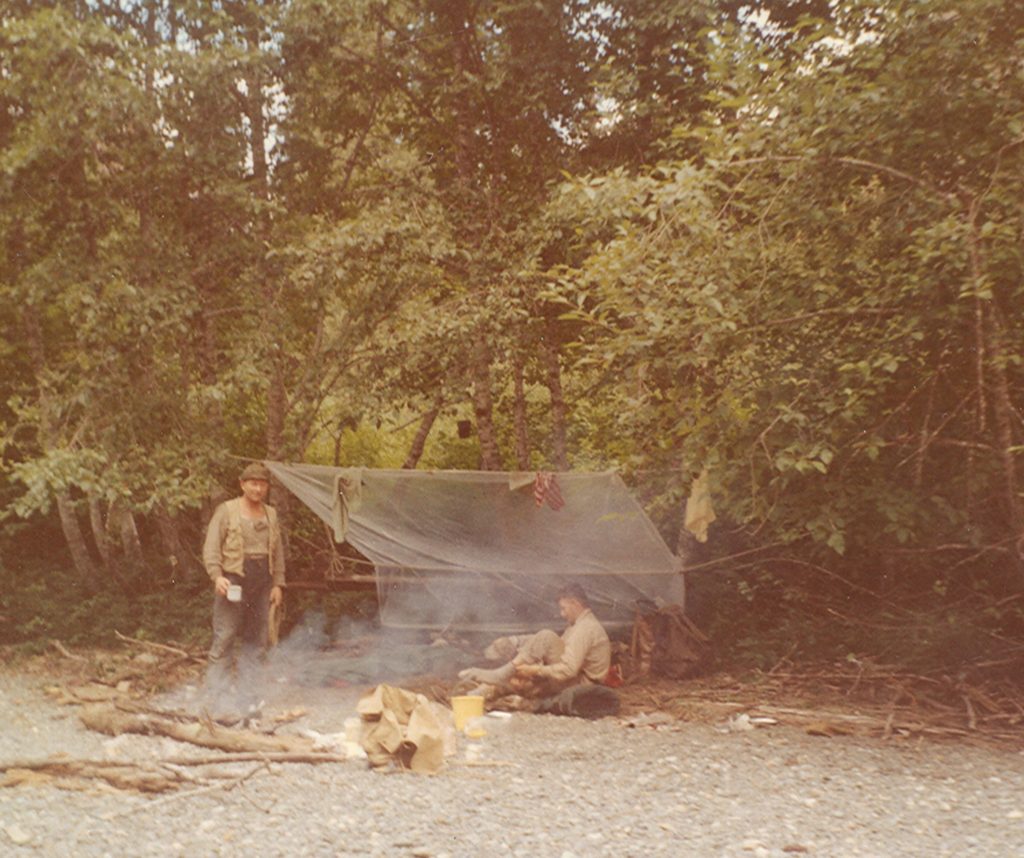
Frank Stapley and Dave Williamson at a fly camp near Stewart Lake on their way to climb Victoria Peak August 1960 – Frank Stapley photo.
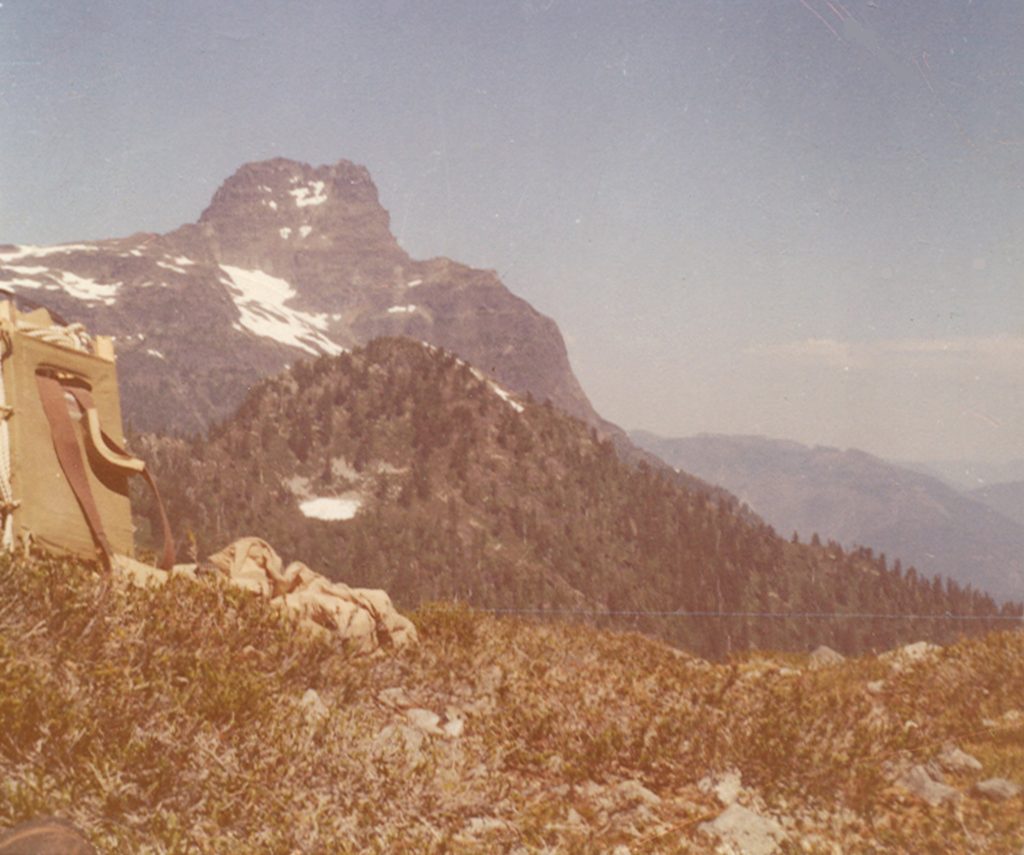
The South Face of Victoria Peak August 1960 – Frank Stapley photo.

Dave Williamson having a wash in a tarn on the South Ridge of Victoria Peak August 1960 – Frank Stapley photo.
1961
ACCVI Executive:
Chairman – Bill Lash
Secretary – Kathleen Tuckey
Events:
Victoria Section’s activities during the summer of 1961 have centered rather particularly on the training in mountain craft of a selected group of boy scouts. Several evenings were given to the outlining of techniques and a number of local climbs were made to illustrate the elements of route-finding, rock climbing and snow climbs. Beginning in March, climbs were made of Mt. DeCosmos, Mt. Tzouhalem and Mt. Sutton. The culminating feature was a visit to the Olympic Mountains and a long climb on Mt. Constance. Eight boys received their mountaineering badges October 7 at Scout headquarters.
The section’s annual dinner was honored by the presence of the President [Bill Lash] who urged us in our local activities not to lose sight of the annual camp and the Rocky Mountains. Paddy Sherman gave an illustrated talk on some of his recent Coast Range climbs.
Some members enjoyed a week skiing at Skoki, while others attended the regular ski camp.
A successful ascent of Mt. Rainer by the Mark Mitchell and Michael Penn.
May – Ralph Hutchinson is part of the 1st All Canadian Party to climb Mt. McKinley (Denali).
July – Rolf and Heather Kellerhals climb in the Taseko Lakes area.
Section members who attended the ACC general summer camp at Goodsirs July 14 – July 28: Ethne Gibson, Roger Spark.
Section members who passed away in 1961: Geoffrey Capes, Frederick Longstaff, George Kinney, Herbert Frind.
Slopes Fine
Reported in The Daily Colonist Friday January 6, 1961. p.10.
Ski conditions on Mount Brenton are reported as excellent, according to the Victoria Sno Birds Ski Club. About a foot of new snow has fallen and both tows will be open Saturday and Sunday.
Ski Centre Planned Near Nanaimo
Reported in The Victoria Daily Times Wednesday February 8, 1961. p.26.
CHEMAINUS—Vancouver Island may soon boast some of the finest skiing in the Pacific Northwest, Chemainus Chamber of Commerce has been told. Art Davies and Al Brawn, members of the Victoria Sno Birds Ski Club, revealed plans for development of ski facilities in the Green Mountain area west of Nanaimo. The club is carrying on negotiations with the E & N Railway to lease 800 acres in and around Green Mountain, and with Crown Zellerbach (Canada) Limited for road access. The site, about 15 miles west of Nanaimo, on the Nanaimo Lakes road, near Second Lake, offers a number of advantages for development as a ski centre.
No Trees
It is largely alpine meadow and free of trees, except for low levels. Because of the elevation, between 4,500 and 5,000 feet, and northwest slope, it can provide good skiing from November to the end of June with 20 to 30 inches of snow. Mr. Davies told the chamber that if lease and access rights are granted, the area would provide skiing equal to, if not better than, anything now offered on the mainland.
Cabin, Lift
The Sno Birds, he said, are prepared to assist in developing facilities and will construct a ski cabin and lift. In previous years the Sno Birds have made Mount Brenton, behind Chemainus, their skiing headquarters, but are faced with having to abandon $6,000 worth of facilities they have developed on the mountain. The area has been virtually closed to the club in recent months by Van-West Logging Co., subsidiary of an American firm, which owns the timber of Mount Brenton.
Island Youth Dies, Two Saved in Fierce Mountain Blizzard
Scout Tragedy on Mt. Brenton
Reported in The Victoria Daily Times Monday March 13, 1961. p.1 & 26.
A 19-year-old Rover Scout died Saturday night in a blizzard on the slopes of Mount Brenton, near Chemainus, while rescue teams in a warm shelter less than one-half mile away prepared to search for him. Dead is Donald Anderson, 19, of Saltair near Ladysmith, one of a three-man party which planned to spent the day in a hike to Silver Lake, near Mount Brenton. In Chemainus general Hospital is David Thomas, 20, Chemainus, reported in poor condition today as a result of severe exposure and frostbitten feet. Third member of the party, Robert McGregor, 18, suffered no ill effects from his ordeal. Ironic twist to the tragedy is that the outing was being taken as part of McGregor’s qualification as a Rover Scout. The other two men were already Rovers and his sponsors on the trip.
Ski Club Member Wins Praise
Sole credit for the rescue effort, conducted over a 24-hour period in winds that blew constantly at from 40 to 50 miles per hour, went to Victoria Sno Birds Ski Club, which has a lodge on Mount Brenton. “The Sno Birds were everywhere and did everything,” said Corporal M.G. Low of Chemainus RCMP detachment. The ill-fated venture started Saturday when the three set off on the trip by which McGregor would prove himself as a Rover. Their equipment was reported as good, but they had only two pairs of snowshoes between the three of them, and snow proved deep with no crust. By Saturday afternoon they ran into the full force of a blinding blizzard, which dumped 4½ feet of snow on the area, dropped temperatures below freezing, and stung them with 50-mile winds. McGregor said after the rescue that when the temperature dropped they decided to try for the Sno Bird Lodge about three miles away. They all knew it well from their experience on previous hike, he said. “Dave was without snow-shoes, so Don decided to try for the lodge himself. After he left us Dave and I continued on. The snow was so deep Dave couldn’t continue, so he decided to build a shelter while I went after Don.”
‘The Wind Was Just Terrible’
“When I found him he was tired. I decided to go ahead at a fast rate to get to the lodge before nightfall. He said ‘Okay’ and agreed to follow at his own speed. The wind was just murder with gusts up to 65 miles an hour. One of his snow-shoes had fallen off when they found him just 300 yards below the lodge. He had fallen asleep. I told him not to. I warned him to keep moving. If he had just looked up, he would have seen the lodge lights and he could have called for help. Rescuers attempted to revive him, but couldn’t. I felt just terrible.” First the 25 Sno Birds at the lodge for the week-end knew of the tragedy was when McGregor arrived there exhausted at about 5 p.m. Saturday. Anton “Toni” Lemprecht, 35, of 5003 Prospect Lake Road, who grew up in Austria and has lived here nine years, said it was 30 minutes before McGregor was able to tell them what happened. “He was exhausted,” he said. “Finally, he was able to explain to me where Anderson was, and that there was a third man on the trail too. When we knew where to go, Manfred Schil, Tony Sayle, Bill Verchere, Brian Saunders, Jack McLellan, a fellow called ‘Frank’ from Qualicum, and myself set out on our skis. I think Anderson was gone when we found him. It is hard to tell—you find someone, you try to revive him, and you think he has a chance. You think you hear him breathing. We put him on a toboggan and took him to the lodge, but I think he was now gone when we first got to him. A nurse, Lyn Phillips (Miss Marilyn Phillips, 4136 Wilkinson Road, Victoria, operating room nurse at Royal Jubilee Hospital) took over with the help of other girls. “I was done in. All I wanted was hot coffee and a quiet corner. It was awful out in the snow. The wind was hard, and our eyes were red. We could only see 50 feet at the outside.” Meanwhile, Barbara Davies, 532 Dallas Road, accompanied by Chuck McLellan and one other skier, went down the mountain to their cars and drove o Chemainus to report the incident to Corporal Low, arriving at his home by 12:30 a.m. They went back to the lodge with a rescue party including Dr. G.J. Phillippson of Chemainus, arriving at 3 a.m. “We had also wanted a helicopter and oxygen, but the weather was impossible and a helicopter couldn’t operate,” Lamprecht said. “I guess we were thinking ahead of ourselves.” Sunday morning Schil, Brian Saunders, a policeman, Lamprecht and others set off to find Thomas. Acting on directions given them by McGregor, they found Thomas in a shelter formed by the root of an upturned tree. He had a fire for part of the night, but his matches were gone by the time the rescuers reached him in mid-morning. “Kare Hellum of Victoria and myself went back to the lodge for another toboggan, arriving there at 2 p.m.” he said. “Barbara Davies, Tony Sayle and Stewart McLeod of Qualicum took the toboggan back to the others.”
Refreshments
The rescuers reached Chemainus with Thomas at 5 p.m. Sunday afternoon. They met at Chemainus fire hall for refreshments provided by the firemen, then returned to Victoria. At press time today, there had been no decision made on holding an inquest. When the weather turned on Saturday afternoon, McGregor and Anderson had planned to make for the lodge in order that one of them could return to Thomas with a second pair of snow-shoes. However, McGregor had been hampered all day by broken straps and when Anderson was found he was with-out one of the shoes.
Tired Out
“His trouble was that his snow-shoe broke and trying to get along without it tired him out,” Lamprecht said. Anderson’s father died three years ago. He lived with his mother and brother William, and worked as a scaler in the logging business. A skin diver and pilot, he was excellent at games and was recognized as the top athlete of the three young men. Thomas was studying to be a meteorologist, recently completed a course in Ottawa and is planning on attending UBC in the fall. Air-Sea Rescue in Vancouver sent a helicopter and two Cansos to the scene Sunday, but they could not assist because of the weather.
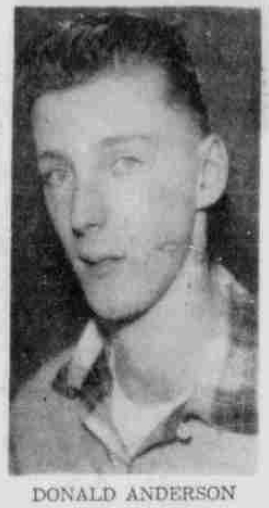
Donald Anderson
Fatal Hike Survivor in Better Condition
Reported in The Daily Colonist Tuesday March 15, 1961. p.9.
CHEMAINUS – David Thomas, 20, who spent 48 hours on snow-swept Mount Brenton before being brought out by a rescue team Sunday [March 13] night was in Chemainus Hospital last night. One of the two survivors of a fatal Rover Scout trip, he is still suffering from exposure, shock and badly frostbitten feet. A coroner’s inquest into the death of Donald Anderson, 19, a companion who died of exposure Saturday night 300 yards from the safety of the Sno Bird ski cabin. A third Scout who took part in the hike that turned into a life and death battle, Robert MacGregor, 18, suffered no ill effects after trudging several miles through a blizzard to alert rescuers that his companion was in trouble.
Courtenay Skiers Win Team Event
Reported in The Daily Colonist Tuesday April 18, 1962. p.11.
NANAIMO—Skiers from Courtenay’s Mount Becher Ski Club won the Mount Brenton Trophy, an inter-club event held at Green Mountain near here Sunday. Stan Rushton, fastest skier, accepted the trophy. Other clubs competing were the ULLR club from Port Alberni and the Victoria-Chemainus Sno Birds. Almost 60 skiers, including 18 racers, journeyed to the mountain. The road was in good condition except for the last two miles. The newly opened site is 100 miles from Victoria. As part of the new development, tows from Mount Brenton will be set up on Green Mountain.
A War to Fight
Reported in The Daily Colonist Sunday June 4, 1961. p.4.
By George Nicholson
This weekend one officer and 12 other ranks of the 1st Battalion Princess Patricia Canadian Light Infantry are making a cross-country trek from the head of Bedwell Sound, an arm of Clayoquot Sound, to Della Lake at the headwaters of Drinkwater Creek which flows into the upper end of Great Central Lake. They follow the footsteps of a similar number of patriotic Englishmen, who, forty-seven years ago, made practically the same trek. The difference is that the purpose of the trek which the PPCLI men are undertaking is part of their training for war, whereas the Englishmen were off to fight a war. The area at the head of Bedwell Sound is rich in mineral deposits, and prior to the First World War an English syndicate operated the Ptarmigan copper mine on Ursus (Bear) Creek, a tributary of Bedwell Sound. Supplies were landed at Tofino from the west coast steamer which came every month, and from there they were ferried by small boat to the head of Bedwell Sound, then back-packed over a rough trail to the mine, a distance of eight miles from tidewater. War broke out on August 4, 1914, but months passed before news reached the camp. Most of the mine employees were British army or naval reservists, which meant they must report to the war office with as little delay as possible. Passage home would be paid as soon as they presented themselves to defence headquarters at Ottawa. Another month would elapse before the next steamer came, but they couldn’t wait that long. Not only the reservists but very man in the camp—13 in all—gathered up a few personal belongings and left. Not down the trail to the beach, then by rowboat to Tofino. Instead, they headed southeast, followed the course of Ursus Creek to the divide, then went down the Taylor River to the head of Sproat Lake. This route is longer by approximately 30 miles that that which the PPCLI party has taken, but the season was mid-winter and as this divide is at a lower elevation there would be less snow. Another advantage was that at least one man in the party had made the same journey before, but in reverse. And the prospectors who discovered and staked the Ptarmigan claims went in by that route. For the soldiers, from Della Lake there is a good trail leading down Drinkwater Creek. They can travel the full length of Great Central Lake by launch or be met by jeep at the network of logging grades in the area. On the other hand, when the 1914 party reached Sproat Lake, they had to construct log rafts and make their own way down the lake. When the Englishmen made their hurried departure, the Ptarmigan mine was left “as is,” machinery and even the plates and dishes from their last meal still on the table. The camp remained that way for many years. Finally, mice and moths destroyed all the clothing and blankets, and one by one, articles of value were looted and carried away. Not one of those Englishmen ever cam back. Today the mine is again being worked, but by new owners.
Green Mountain
‘Best Ski Hill on The Coast’
Reported in The Daily Colonist Sunday August 27, 1961. p.17.
By Edmund Cosgrove
Victoria Sno Birds Ski Club executive has approved expenditure of $13,000 this year for development of what is hoped will be the “finest ski mountain on the West Coast.” Club president Art Davies said a lease has been signed with an up-island logging company for rental of 500 acres of “perfect alpine meadows” atop green Mountain, in the Nanaimo Lakes area.
Access Road
At an executive meeting Wednesday, members approved expenditures for development of an access road to the property, construction of a three-storey ski cabin and installation of one of the clubs two ski lifts. At the same time, the club will seek to boost present Victoria membership of 180 to double that amount, besides going ahead with plans to meet with “interested parties” in Nanaimo in the hope of creating an affiliated ski club there.
Chemainus Club
The Sno Birds have already helped found the 40-member Chemainus Sno Bird’s Ski Club. “The new property,” said Mr. Davies, “is probably the best skiing area on the West Coast of B.C.” The club was previously located on Mount Brenton near Ladysmith.
One More Season
“We can still hold one more season there if work on the Green Mountain development gets mowed out,” he said. “A number of factors prompted the decision to move,” he said. “For one thing, there is more snow. Then the area is more accessible, but more important, we now have a lease on the property.”
Verbal Agreement
He said the Mount Brenton property was held “only on a verbal agreement.”
Reforested
Besides that, the area had been reforested and stumps from previous logging operations interfered with ski runs. Plans call for construction of a road by a contractor to the 4,300-foot level of Green Mountain. Meanwhile club members will prefabricate sections of the “A” fame, 50-foot by 20-foot ski lodge. The sections will be trucked in when the access road is completed and the lodge erected on top of the 5,000-foot mountain. “We have first-rate instructors and we hope to eventually provide membership coverage for all the lower tip of Vancouver Island,” Mr. Davies said.
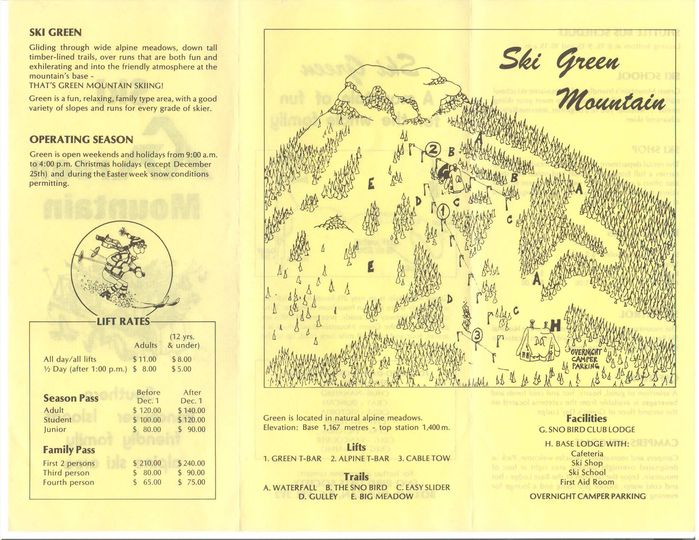
“Ski Green Mountain” brochure.

Ski Green

Ski Green Mountain
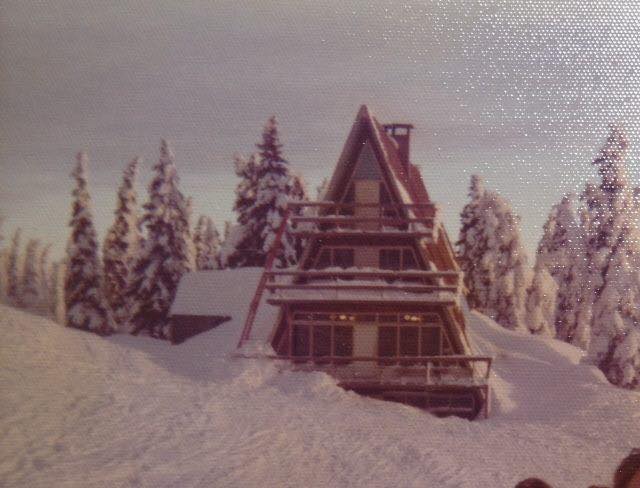
Green Mountain Lodge
Historian And Scholar Major Longstaff Dies
Reported in The Daily Colonist Thursday October 5, 1961. p.5.
Active in Victoria affairs since 1911 and an authority on the history of the city and its environs, Major Frederick Victor Longstaff, 83, died early yesterday [October 4] in Royal Jubilee Hospital. Major Longstaff underwent an operation Tuesday after a fall last week at his home, 50 King George Terrace, in which he suffered a fractured hip.
Trained Architect
Native of Surrey, England, he was a trained architect. Major Longstaff was a veteran of the Imperial Army. His interests here took in a wide field of history on land and at sea. He gathered a notable collection of pictures and records of the early days in the province.
Nearby Waters
From his home where he lived for years with his wife, Jennie [nee McCulloch], who died in 1957, he kept a close eye on nearby waters. With the aid of a telescope, Major Longstaff allowed little of ships or shipping to go by unnoticed and would frequently advise the Colonist of some newsworthy event offshore. “He was a most knowledgeable man, a scholar in the best sense,” said Miss E. Guilliland, his housekeeper for 18 years.
Three Histories
He wrote histories of Christ Church Cathedral, HMCS Naden and Esquimalt Harbor. Major Longstaff became a recognized authority on the Royal Navy and Royal Canadian Navy and was closely associated with the Maritime Museum at Signal Hill. He was a life member of the Army, Navy and Air Force Veteran’s Association, which he joined in 1917, and of the Oak Bay Progressive Conservative Association. In addition, he was a member of the B.C. Historical Society, the Victoria branch of the Canadian Authors Association, the Alpine Club of Canada, the Union Club of Victoria and of the boards of the B.C. Protestant Orphanage and Royall Jubilee Hospital. His work as an architect included assisting in the design of St. John’s Anglican Church and the James Bay Anglican Hall.
Survivors Named
Survivors include two brothers, Thomas [of Mt. Everest fame] and Gilbert in Britain, and three sisters. Dean Brian Whitlow will conduct funeral services Saturday at Christ Church Cathedral. The cortege will leave Hayward’s funeral home at 3:15 p.m. and services will start at 3:30 p.m. to be followed by cremation.
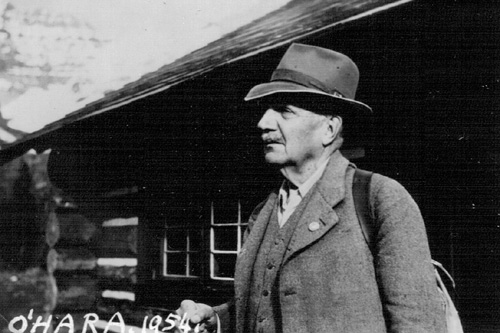
Frederick Longstaff at the Alpine Hut at Lake O’Hara 1954 – Photograph from the MacFarlane collection.
Climbers’ Badges for Eight Scouts
Reported in The Victoria Daily Times Friday October 6, 1961. p.20 & 29.
Eight Scouts from troops of the Greater Victoria region will be presented with their Mountaineer’s badge Saturday at regional headquarters, Johnson Street. The mountaineering course was run by the Victoria section of the Alpine Club of Canada under Reginald Knott, Noel F. Lax, Bill Lash and C. Thomas W. Hyslop. These awards follow a strenuous climbing course which began in March and involved scouts scaling such mountains as De Cosmos, Sutton and Tzouhalem. The climax to the course was reached over the Labor Day week-end when the boys tackled 7,739-foot Mount Constance, second highest peak in the Olympic National Park.
Skiers Do It Themselves
How Dreams Come True
Reported in The Daily Colonist Friday October 13, 1961. p.12.
By Jim Taylor
If Victoria Sno Birds can ski as well as they scrounge, they all belong in the Olympic Games. The Sno Birds started with nothing but a lease on the slopes of Green Mountain 30 miles by road from Nanaimo and a fierce determination to build a lodge there. With no money, no equipment and no previous experience, they set out seven months ago to raise $10,000 for the job. It seemed impossible. But this weekend the 170-member club will lay the foundation for a three-storey lodge at the 4,200-foot level of Green Mountain. To get there they will travel over a two-mile stretch of road they hacked out of the slopes themselves, and later this month they will build a lodge they prefabricated themselves in Langford. It’s been a do-it-yourself project with vengeance. Most of the $3,500 raised since April has come through sale of $75 debentures (repayable in five years as $100), but no money-making project, no matter how small, has been overlooked. A bottle drive netted $100. There have been rummage sales, a raffle, and even a casino night at a member’s house. “I do hope it’s legal,” one club member inflected. But the most amazing part of the whole venture is the driving, boundless enthusiasm the club has been able to generate not only in its membership, but in outsiders, many of whom do not even ski.
For Nothing
One man volunteered to pick up 7,000 board feet of lumber at Port Alberni and deliver it to the mountain. A Nanaimo architect designed the lodge for nothing. A cement company donated 60 sacks of cement and a lumber company chipped in with 50 sheets of plywood. Club members gave up their weekends for work parties, slogging through deep mud to build a two-mile road from the parking lot to the cabin. One member went to the bank and borrowed $6,500 to purchase a snowmobile, serenely confident that the club will be able to pay him back.
Acts Accordingly
The club feels that every cent saved brings the completed project that much closer, and acts accordingly. Excerpts from its monthly newsletter provide a striking chronicle of the project. One letter instructs members to bring a certain coffee company’s coffee bags to the general meeting because “we are only 25 bags away from our target of 295, the total required for obtaining the coffee urn.”
Other Tasks
The next letter reports that the new urn is in operation. That disposed of, it sets a few others little tasks for the membership. “To transport the building materials we need a fleet of pick-up trucks, tractors, jeeps, etc. Please check to see if you can get one or more for one or two weekends. We also require the use of a concrete mixer, several hundred feet of ¾” plastic waterpipe, and we still need 370 sheets of plywood.” Silly requests? Maybe, but they got them all filled.
Building Bee
Skiers from Nanaimo, Chemainus and Victoria plan to give up a week of their holidays and go to the site en-masse to build the cabin. The lodge will be finished well enough to be habitable for the November to June season. When it is completely finished it will be a three-storey glassed-in wonder, complete with a kitchen, coffee shop, ski shop and sleeping facilities for 70.
Far From Over
The job is far from over. Thousands of dollars still have to be raised, and it will mean more fund drives and more work. When it is over, the skiers who sat back and watched will undoubtedly flock to join the Sno Birds and enjoy the finished product. Strangely enough, that doesn’t bother the club. “We’ll let them join,” one member said. “If they had joined earlier they wouldn’t have worked anyway. There are always laggards.” There aren’t many in the Sno Birds.
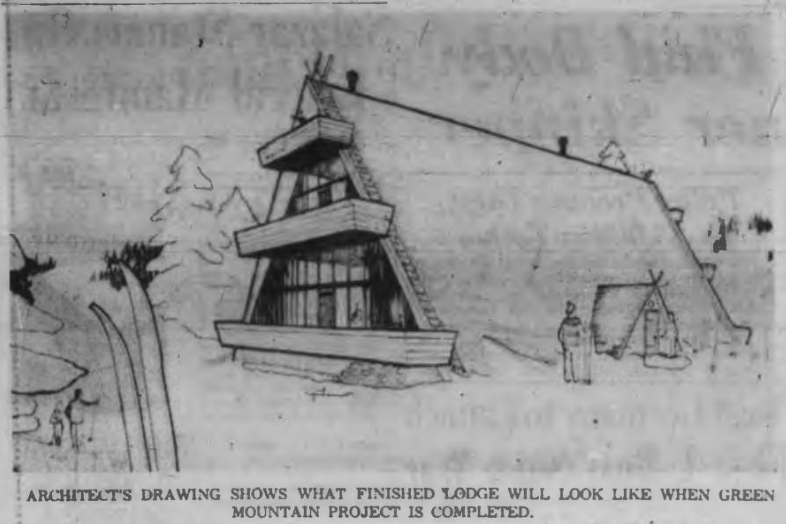
ARCHITECT’S DRAWING SHOWS WHAT FINISHED LODGE WILL LOOK LIKE WHEN GREEN MOUNTAIN PROJECT IS COMPLETED.

Grade ‘A’ Product: Prefabricated “A” frame sections of lodge were built in Langford by club members like Manfred Schil, then dismantled and taken to mountain.
Green Mountain
Sno Birds Start on New Ski Lodge
Reported in The Victoria Daily Times Monday October 30, 1961. p.34.
NANAIMO—Victoria Sno Birds Ski Club has started work on its new ski lodge at the 4,500-foot level on Green Mountain, near Fourth Lake and 22 miles west of here. Members worked in three feet of snow Sunday as the first load of lumber arrived at the site – delivered on a sled towed and winched up the rough road by tractor drivers Jack Skertchly and Sandy Stills of Duncan. Machines for the job were loaned by George Whittaker of Maple Bay.
Three Stories
The club, with sufficient funds available through sale of debentures, will build a lodge measuring 28 by 57 feet, of a A-frame design, with three stories. Work will be done by members and other skiers from Nanaimo and elsewhere on Vancouver Island. One rule has been fixed: no skiing until the roof is on the building. Despite the temptation of three feet of new snow, members did not even take their skis with them on the weekend, but stuck to the job until Sunday night.
Rough Trail
Cars can be driven within one and three-quarter miles of the lodge. The remainder of the route is a very steep and steady climb over a rough trail only recently cleared by bulldozer. By December, snow will be too deep for cars, but a snow-mobile is due to arrive December 15 to cover the last few miles. The mountain itself is 4,800 feet in height, and the ski area will not be over logged-off land, but on Alpine meadows clear of snags and underbrush. Members claim they will have more snow than Grouse Mountain, and what may be the best skiing area in British Columbia.

Well-Known Mountaineer Dead At 89
Reported in The Victoria Daily Times Wednesday November 15, 1961. p.13.
Reverend George Kinney, who pioneered the sport of mountaineering in Canada, died at the Veteran’s Hospital Tuesday [November 14]. He was 89. A United Church minister, Mr. Kinney was better known as the conqueror of Mount Robson, the highest peak in the Canadian Rockies. He scaled the 12,972-foot mountain in 1909. In 1911 he was a member of an alpine party which climbed and explored 40 peaks on the border of British Columbia and Alberta. In all he scaled about 100 mountains on the Mainland and Vancouver Island. He was also a pioneer Canadian alpine photographer. The bulk of his collection of pictures today is owned by the British Alpine Club which made him a fellow for his achievements in Canada.
War Veteran
Born in New Brunswick, he served in the First World War with the 4th Field Ambulance. He served as a clergyman at Koksilah, Mill Bay, Shawnigan, James Bay and Cumberland. He is survived by the widow, Alice; two sons, Bliss of Duncan, and Don of Vancouver; one daughter, Mrs. Dave McFarlane of France; a sister Mrs. Ellen Sanders, Amherst, Nova Scotia, and two brothers living in the United States. Funeral service will be held at McCall’s Chapel Friday at 3:15 p.m.
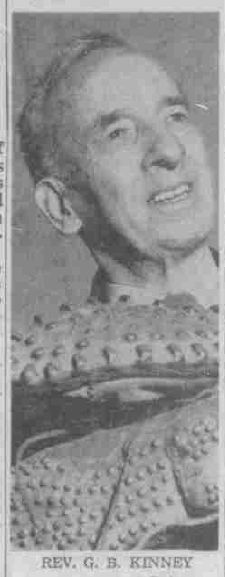
Rev. G. B. Kinney
Major Frederick Victor Longstaff
Reported in the Canadian Alpine Journal Volume 45, 1962. p.128-129.
By Muriel Aylard
With the death of Major Frederick Victor Longstaff in Victoria, B.C, October 1961, the Victoria Section has lost a valued member. Major Longstaff was born in Ilkley, Yorkshire, England, June 15, 1879 and was educated at Eton and Cambridge. He obtained a diploma in Agriculture. Later he was ab articled pupil to an architect in London. He practiced his profession there and later Victoria, B.C., working with Colonel Ridgeway-Wilson, architect of St. John’s Church which was partially destroyed by fire a year or so ago. A trip to Glacier, B.C. with his family in 1903 was a prelude to repeated trips to the Selkirks and Rockies. He joined the Club in 1911. In the mid-twenties his name was added to the original Hut Club Committee. For many summers he spent several happy weeks at Bow Lake. Lake Louise and Lake O’Hara. Lake O’Hara was his favourite and in 1961 he was there as usual. He protested against the change of transport—horse to bus! In 1931, with Christian Hasler and Ernest Feuz, he explored the Bridge River Icefield area and also, in 1938, with Walter Feuz he made a pack pony t to Bella Coola, Mount Monarch. Major Longstaff had varied interests. For years he was Vestry Clerk and Registrar of the Sunday School at Christ Church Cathedral. From 1933 on he was Dominion Secretary of Soldiers’, Sailors’ and Airmen’s Help Society, London. He held a commission in the Territorial Force. The Boy’s Brigade and in 1911 joined the active Militia of Canada. Also, he was a member of Toc-H and the Royal United Service Institute, Whitehall, London. Photography, geography and history were some of his other hobbies. The Royal geographic Society made him a fellow in 1896. Every passing ship he noted from his home overlooking the Strait of Juan De Fuca. Much of his time in later years was spent collecting historical data. He compiled a naval history of Esquimalt, B.C., and a history of Christ Church Cathedral and also of Glacier, B.C. His valuable library of five thousand volumes, many pamphlets and photographs he bequeathed to the British Columbia Provincial Archives. Major Longstaff was predeceased by his wife Jennie Long McCulloch, who became an active member of the Club in 1912. Among those surviving him are his sister and brother, both Life members of the Club; Mrs. A.F. Wedgewood and Dr. T.G. Longstaff. The latter is a veteran climber in the Himalayas, Greenland, Canada and Europe.

Major Frederick Victor Longstaff
Geoffrey Bernard Capes
Reported in the Canadian Alpine Journal Volume 44, 1961. p.136.
By Bill Lash
Members of Vancouver Island have felt keenly the loss by death of one of its senior members, Geoffrey B. Capes. Mr. Capes came to Canada from England just before the first World War and after serving overseas in the Canadian Army returned to this country and settled at Courtenay. In exploring this new environment, he was particularly attracted by wild mountain area lying in the centre of the island. There were few logging roads in those days, and long arduous back-packing was exacted by those who penetrated this wilderness. Geoffrey Capes made many early ascents including the Golden Hinde, Elkhorn Mountain, Argus Mountain and The Red Pillar, and became an authority on the Comox Glacier and Buttle Lake country. He was a charter member of the Comox District Mountaineering and Ski Club. Until his death Mr. Capes joined many of the weekend and longer camping trips of the Victoria Section. Among places visited on these occasions may be mentioned, the Comox Glacier country (where his card dated in the early twenties was found in the cairn), Elkhorn Mountain, Mount Garibaldi Park and Mt. Constance. Besides climbing he loved fishing, and provided many a welcome addition to the camp mess. His unfailing and kindly sense of humour, as well as his keenness whether for climbing or more prosaic camp activities, will be greatly missed by the section. Geoffrey Capes was saddened last autumn by the death of his wife Nell. He is survived by two daughters one of whom, Katherine, resides in Ottawa and is a member of the club.
1962
ACCVI executive:
Chairman – Tom Hyslop then Paddy Sherman as acting chair.
Secretary – Kathleen Tuckey
Section Fees:
$10.00 Active and Graduating Member of ACC.
$7.50 Associate member of ACC.
$2.00 These same members, of all three categories, when belonging to the local section.
If the main club fees are paid through the local Section, that Section is entitled to retain 50 cents per member.
$2.50 Associate member of the Victoria Section.
ACC badges $1.75.
Events:
March – Ski trip to Hurricane Ridge (Washington) – Accommodation: $6.00 per couple. Ferry: $4.00 return per passenger, $12.00 return per car. Bus to ridge if eight persons or more in bus $1.90 per person.
Members made two ski trips to Hurricane Ridge and one to Green Mountain. Twelve members climbed Mt. Todd and ten ascended the North Ridge of Mt. Whymper.
April – Club’s annual banquet held at Hollywood House. The guest speaker was Ralph Hutchinson who showed slides of his 1961 All-Canadian ascent of Mt. McKinley. Dinner – $2.50 per person.
May 21 – Paddy Sherman and Mike Hanry day-trip Mt. Arrowsmith.
May 27 – Club trip to the north ridge of Mt. Whymper. Ten people summit.
June 30-July 2 – Bill Lash, Pat and Elizabeth Guildbride climb Hkusam Mtn.
July 1 – Three members made a new route on the East Face of Mt. Shuksan.
Dr. Michael Penn showed slides of his climb of Mt. Rainer with Mark Mitchell.
September – Rolf and Heather Kellerhals climb Fluted Peak (1st ascent) and Mt. Monmouth in the Monmouth Group.
September 22/23 Fred Crickard, Paddy Sherman and one other climb Mt. Shuksan.
October 6/7/8 – Syd Watts leads a trip to Moat Lake. Attempt Mt. George V.
October 20 – Slides of Maligne Lake camp at Michael Penns at 4045 Rainbow St.
Section members who attended the ACC general summer camp at Maligne Lake July 14 to July 28: Bill Lash (climbed Mt. Moffat), Dorothy Lash, Kathleen Tuckey, Patrick Guilbride (climbed Mts. Brazeau, Henry McLeod and Valad Peak), Elizabeth Guilbride, Peter Haegert (Mt. Brazeau), Edith Maurice, Eric Maurice (graduated on Mts. Charlton and Unwin), Ethne Gibson, Edward Goodall, Michael Penn and Rosemary Penn (climbed Mt. Replica).
The section began a new newsletter called Crag N’ Crevasse which will come out four times a year.
Section members who passed away in 1962: William Dougan, Edward Wheeler.
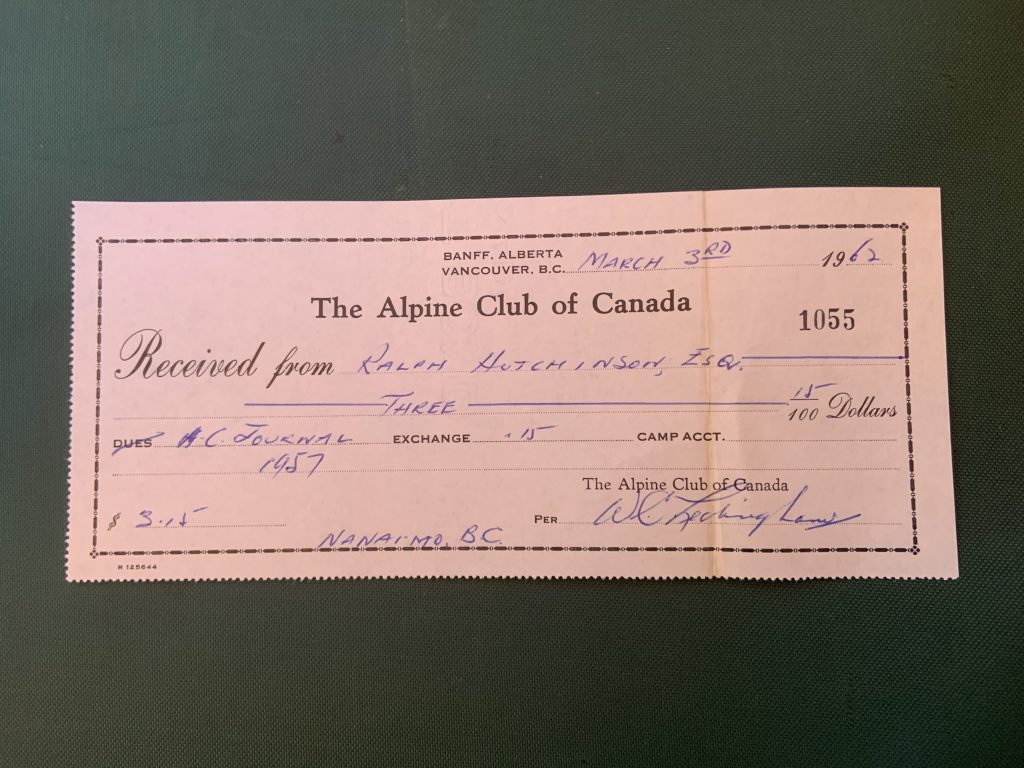
A copy of Ralph Hutchinson’s ACC membership receipt.
Green Mountain Draws Skiers
Reported in The Daily Colonist Sunday January 21, 1962. p.19.
The Victoria Sno Birds Ski Club are justly proud of their development at Green Mountain Last Sunday about 130 persons climbed the 4,800-foot mountain in the Nanaimo Lakes area with access through the Comox Logging Company’s gate, and had a terrific day’s skiing. About five inches of snow had fallen overnight and conditions were ideal. Many of the people skiing were from Alberni, Nanaimo, Qualicum Beach, Ladysmith and Chemainus. The club boasts a rapidly-growing membership from those points as well as from Victoria. The club has a three-storey A-frame lodge partly finished and suitable overnight accommodation will be available for club members and their guests by next season. Full equipment rental facilities are now operating.
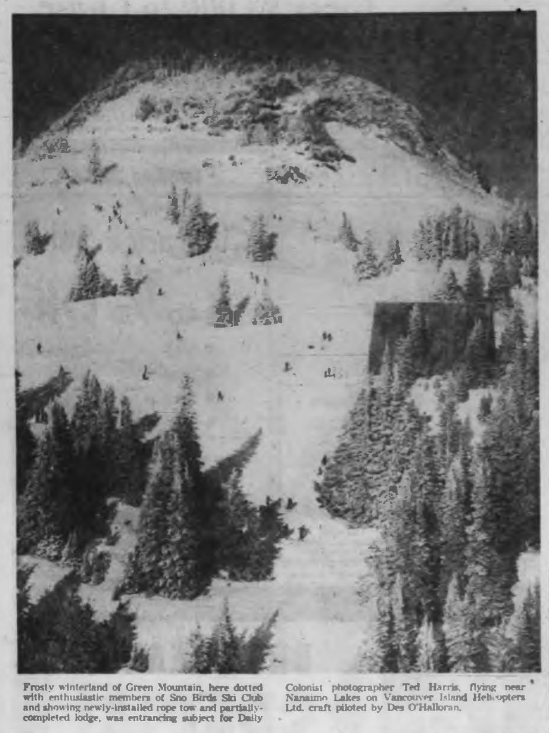
Frosty winterland of Green Mountain, here dotted with enthusiastic members of Sno Birds Ski Club and showing newly-installed rope tow and partially-completed lodge, was entrancing subject for Daily Colonist photographer Ted Harris, flying near Nanaimo Lakes on Vancouver Island Helicopters Ltd. craft piloted by Des O’Halloran.
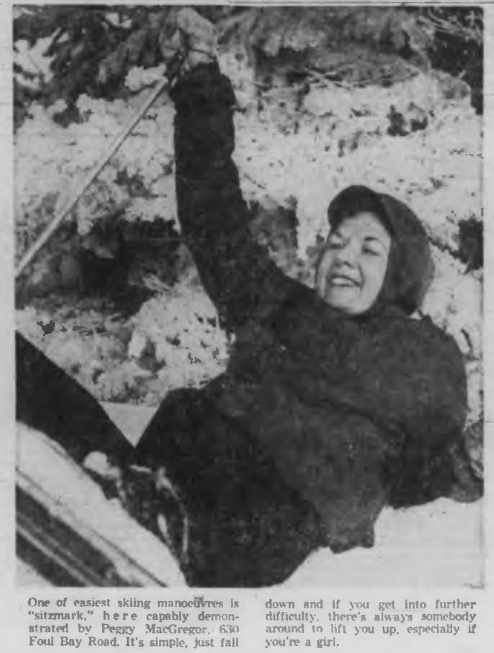
One of easiest skiing manoeuvres is “sitzmark,” here capably demon-strated by Peggy MacGregor, 630 Foul Bay Road. It’s simple, just fall down and if you get into further difficulty, there’s always somebody around to lift you up, especially if you’re a girl.
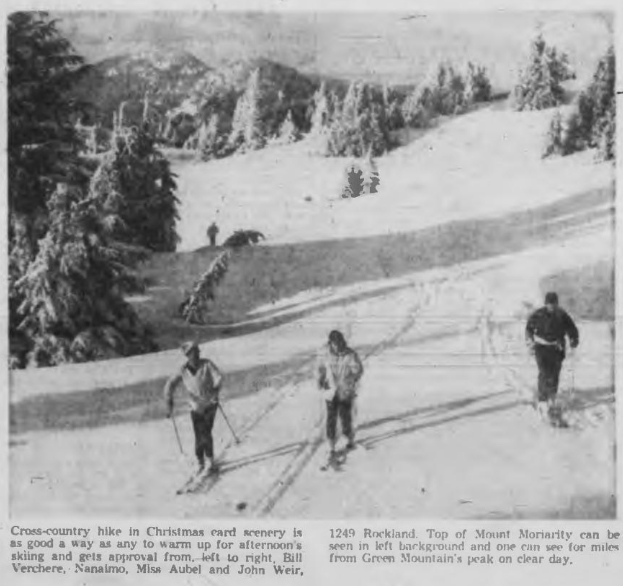
Cross-country hike in Christmas card scenery is as good a way as any to warm up for afternoon’s skiing and gets approval from, left to right, Bill Verchere, Nanalmo, Miss Aubel and John Weir, 1249 Rockland. Top of Mount Moriarty can be seen in left background and one can see for miles from Green Mountain’s peak on a clear day.
![Best ideas for snow bunnies (neophytes) is good instruction. Here Jo Ann Aubel, 1887 Feltham, explains intricacies of parallel siding to, left to right, Hubert Mooney, 989 Admirals; June Price, 4124 Hawkes; Brenda Runge, Yellow Joint [sic] Lodge; Ellen Ware, Ladysmith; and John Connor, Port Alberni.](https://accvi.ca/wp-content/uploads/1962_Jan_21_4.jpg)
Best ideas for snow bunnies (neophytes) is good instruction. Here Jo Ann Aubel, 1887 Feltham, explains intricacies of parallel siding to, left to right, Hubert Mooney, 989 Admirals; June Price, 4124 Hawkes; Brenda Runge, Yellow Joint [sic] Lodge; Ellen Ware, Ladysmith; and John Connor, Port Alberni.
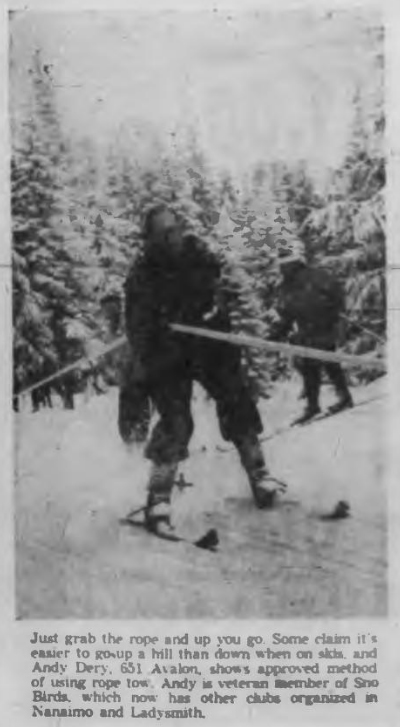
Just grab the rope and up you go. Some claim it’s easier to go up a hill than down when on skis, and Andy Dery, 651 Avalon, shows approved method of using rope tow. Andy is veteran member of Sno Birds, which now has other clubs organized in Nanaimo and Ladysmith.
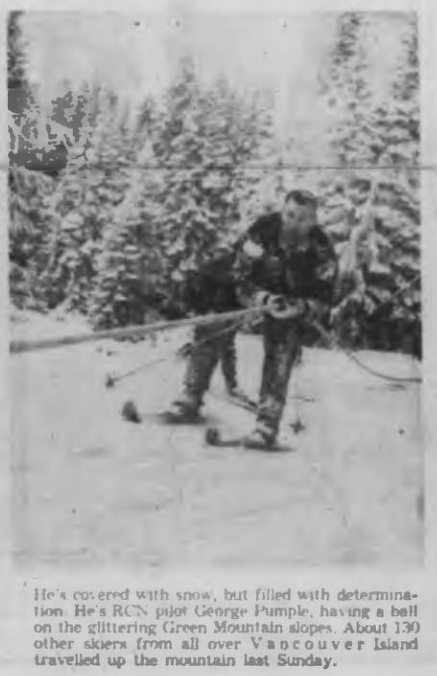
He’s covered with snow, but filled with determination. He’s RCN pilot George Pumple, having a ball on the glittering Green Mountain slopes. About 130 other skiers from all over Vancouver Island travelled up the mountain last Sunday. All photos by Ted Harris.
Ski Crowns to Courtenay
Reported in The Daily Colonist Tuesday March 20, 1962. p.10.
Courtenay skiers won two races at Green Mountain Sunday. The Courtenay team took the Mount Brenton Trophy race, beating Port Alberni and Green Mountain, and Herb Bradley of Courtenay won the two-mile downhill Kandahar race in four minutes, 16 seconds. Sno Bird skiers compete in the Nanaimo Centennial Trophy races Sunday at Green Mountain.
Tom Hyslop Heads East
Reported in The Daily Colonist Thursday May 24, 1962. p.18.
Eastward Ho! Off to Ottawa is Tom Hyslop, genial superintendent of lands in the provincial government. Mr. Hyslop has been with the B.C. land department since 1947. He will leave June 15. In his new position he will be responsible for the administration of federal lands, mineral resources and timber in the Yukon, Northwest Territories and the provinces. His leaving does present a couple of problems. For one thing, he has to sell a house he is just building here. For another, members of the Victoria section of the Alpine Club of Canada are going to have to shop around for a new chairman.
William Holmes Dougan 1872-1962
Reported in The Canadian Alpine Journal Volume 46, 1963. p.122-123.
By Fred Maurice
William Holmes Dougan, who died in Victoria on August 10, 1962, had been a member of the ACC for over fifty years. He joined along with the late Major Frederick V. Longstaff, in 1911. Both were close friends of the late Arthur O. Wheeler, who with Mrs. Elizabeth Parker, had founded the Club only five years previously. Born near Seattle, Washington, on December 8, 1872, William Dougan was a member of the Mazamas in his early years. He did considerable climbing in the States before coming to live in Victoria and joined the Club as an experienced mountaineer. An old newspaper clipping supplied by his daughter records a climb of Mt. Adams in which he participated in 1902 with the Mazamas. One of the other climbers listed is Governor T.T. Geer. From 1911 to the late 1920’s Mr. Dougan attended several Annual Camps and in about 1924 travelled by horseback from Banff to Jasper. In 1925 he was Chairman of the Vancouver Island Section, and was active in the Section until about 1940. In the late 20’s he was active in the exploration of the Forbidden Plateau area on Vancouver Island. An extremely active man and a great lover of the outdoors, he had little interest in anything that did not involve hard work. To get him to go on a trip merely for the pleasure, was next to impossible. For a work party he was the first to volunteer. He lived in the present; he would sit at the campfire and discuss the job to be done tomorrow; what had been done yesterday was past, so there was no point in discussing it. A member of a very old American family, Mr. Dougan was a nephew of the late Oliver Wendell Holmes, who was Chief Justice of the USA during the Roosevelt administration. During the 40’s his eyesight failed, forcing him to give up most of his associations, but he never forgot a voice he had known. One could pass within a few feet of him on the street, and he would not recognize you, but say “Good Morning,” and he would call you by name. The world could do well with a few more like the late William Holmes Dougan.
1963
ACCVI executive:
Chairman – Paddy Sherman
Secretary – Kathleen Tuckey
Events:
July – Ralph Hutchinson, Geoff Suddaby and two others make the 1st ascent of Mt. Winstone in the Taseko Lakes Region. It was named in honour of Harry Winstone founder of the Island Mountain Ramblers.
Sno Birds Ready for Opening Day
Reported in The Daily Colonist Friday January 18, 1963. p.13.
NANAIMO—The Green Mountain Sno Birds Ski Club Wednesday decided final details of the formal opening by Recreation Minister Earle C. Westwood January 27. The Mayors of Nanaimo [Pete Maffeo] and Victoria [Richard Wilson] have been invited. An urgent call for dishes went out to members. Five hundred people were on the mountain last weekend. President John Thomson asked member to make opening day memorable. The executive considers the day vital in the future of the club.
Government Favors Ski Plan
Reported in The Daily Colonist Thursday February 14, 1963. p.12.
Earle C. Westwood, Provincial Minister of Recreation and Conservation, yesterday looked favorably on a report that the government would be asked to buy 390 acres on top of Green Mountain to aid in the development of a Vancouver Island ski resort. The land, leased yearly by the Sno Birds Ski Club from the Esquimalt and Nanaimo Railway for $1 per year, was opened to club members two years ago and had proved to be a limited success – limited by the difficulty skiers encounter in getting up to its slopes at the 4,900-foot level. Were the government to buy the land, and turn it into a Provincial Park, investors would be tempted to install a chairlift, in the ski club’s opinion. The railway company has indicated that it would sell the land to the provincial government, but to nobody else, said the club. Access to the mountain is gained through the Comox Logging Company’s Nanaimo Lakes timber area, on a general permit basis. The logging company maintains a gate that is opened only on weekends. “I haven’t been approached on the purchase yet,” said Mr. Westwood. “If I am, we will take a good look at it, depending of course upon the amount of money involved. We in our department like to encourage local effort such as this and I think it’s right that we should,” said the minister. “It all depends upon the evaluation the railway company put on the land. I certainly agree that a chair lift would be the answer to the ski club’s problem and we’ll do all we can to help bring it about.”
Outdoor Club, Island Ramblers Beat Golden Hinde
Four Men Reach Summit
Reported in The Daily Colonist Sunday September 1, 1963. p.11.
Last year Victoria and Island hikers were beaten by bad weather, but this year a party of eighteen got around to tackling the Golden Hinde, the Island’s highest mountain. Four of the eighteen recently made it to the top of the Golden Hinde, 7,219 feet, with Victorian Hans Rufager and Dale Paterson, Ron Facer and Greg Shoops, all of Nanaimo, braving the 14-hour assault.
Pimple Too
Meanwhile another party went up The Pimple [now known as The Behinde] in a 12-hour hike. The Pimple is the unofficial name of the Golden Hinde’s sister peak. “We could holler across the mile-span to the other party,” said hiker John Cowlin, assistant municipal engineer in Saanich. “We headed down from The Pimple and saw icebergs floating in an unnamed lake north-westerly of the main peak,” he said.
Meet Again
When the two parties met again at the camp 400 feet above Burman Lake at Night, “we caught the tail end of a thunderstorm August 12—flash and thunder were about one second apart, really close.” Another spectacular sight for Mr. Cowlin and his fellow hikers from the Outdoor Club of Victoria and the Island Mountain Ramblers was the trial of a 1946 earthquake.
Devastation
“We hiked up Elk River to the unnamed lake below Mount Colonel Foster and saw the devastation caused when the tower broke off the mountain, crashed through timber 3,000 feet into the lake and rumbled down the valley for 1½ miles,” Mr. Cowlin said. “The masses of earth stripped the riverbed right down to bedrock. The timber was shorn off in a path about 500 feet wide—it was a fantastic sight.”
Route Listed
Here is the route the 18 hikers followed:
August 10: Fly-in from Campbell River and Buttle Lake to Burman Lake.
August 11: Climbed Mount Burman, went down other side.
August 12: Assault on the Golden Hinde and The Pimple.
August 13: Party clouded in. Stayed around camp.
August 14: More poor weather.
August 15: Party flew out to Buttle Lake, camped on Upper Elk River.
August 16: Hike up Elk River to Mount Colonel Foster.
August 17: Drive to Gold River, cruise to Friendly Cove.
August 18: Back to Victoria and Island points.
Party included: Tom Lyus, John and Doreen Cowlin, Syd Watts, John Richardson, Jane Waddell, Joyce Clearihue, Suzanne Folsey, Hans Rufager, Ron Facer, Dale Paterson, Greg Shoops.
Island Climber to Tackle Peak in Himalayas
Reported in The Victoria Daily Times Wednesday December 18, 1963. p.21.
A Nanaimo alpine climber has been chosen to participate in a Canadian mountaineering expedition in northwest Pakistan next spring. Geologist John Ricker, 25, son of W.E. Ricker, acting chairman of the federal fisheries research board, will attempt a world record by scaling the 24,451 Malubiting Mountain in the Himalayan Rakaposhi range.
Eight Men
The expedition, to consist of eight men, will be headed by Dr. Ernest F. Roots, a 40-year-old Ottawa geologist. Mr. Ricker, now in New Zealand, is well-known by Victoria climbers.
In Antarctica
Bill Lash, former president of the Victoria section of the Alpine Club of Canada, said he has done some extensive climbing in B.C. Mr. Ricker also took part in an Antarctic expedition. The expedition to the unconquered Malubiting peak will coast each member about $3,200. The party is scheduled to be assembled in Rawalpindi May 9, when it leaves for Gilgit in the Himalayan foothills.
1964
ACCVI executive:
Chairman – Paddy Sherman
Secretary – Kathleen Tuckey
Events:
May 16-18 – Syd Watts led a trip to Crown Mountain
June 14 – Mt. Hooper
July – Elk Valley trip
July 18/19 – Trip up Mt. Arrowsmith
July 25 to August 16 – Syd Watts and John Cowlin led a trip from Forbidden Plateau to the Comox Glacier, Tzela lake, Flower Ridge to Cream Lake, Bedwell Lake then on to Burman Lake and the Elk River Pass.
August – Ralph Hutchinson, Paddy Sherman and others make the 1st ascent of Mt. Harrison on the mainland. The last 11,000’er in the Canadian Rockies to be climbed.
Parks Policy Alarming
Reported in The Daily Colonist Sunday March 1, 1964. p.4.
The Comox District Mountaineering Club views with alarm Mr. Kiernan’s announcement that provincial parks will be made available for commercial ventures. Under such a system we may as well face the fact that we will never be able to feel secure about our parks. We conservationists will only avert our gaze for a moment, and something else will be gone. What a pity! It’s it sorely letting down the men who had the vision and foresight to set aside these wonderful wilderness areas for us? We believe our parks should be saved in their natural state forever, for the enjoyment of all outdoor lovers, and safely out of reach of the politician and promoters. From past observation, we are fearful that there always will be a big enough reason advanced and sufficient pressure brought on the government to put all these choice areas under the axe. We acknowledge that our economy depends on the use of our resources, and we also admit that we are assisted greatly by use of industrial roads leading to out park areas, BUT our parks themselves must remain forever the property of the people and be cherished. Enough of our lovely streams have been jammed with logging debris and fouled mine pollution, with untold destruction of wild life and fish.
Keith Morton
President CDMC
Two Island Men in Himalayan Team
Reported in The Daily Colonist Wednesday April 29, 1964. p.17.
By John Bird
OTTAWA—Four B.C. men, two of theme Vancouver Islanders, are among the eight who soon will make the first Canadian assault on the Himalaya Mountains in West Pakistan. The leader is Dr. Ernest F. Roots, 41, a native of Salmon Arm and now coordinator of Canada’s polar continental shelf project. His deputy is Powell River school teacher Robert “Don” Lyon*, 27. The Islanders are Donald Poole, 26, an engineer from Courtenay, and John Ricker, 26, a Nanaimo geologist. The others are Calgary geologist Carlisle Irwin, 27, Toronto aircraft engineer Hermann Jamek, 34, and two Montreal doctors, Abdul Momin Khalifa, 34, and Karl Tomm, 25. The Pakistani government will select the peak they will scale, informing the team when it assembles in Rawalpindi May 9, but the expedition wants to try an unconquered mountain. Dr. Roots say the choice is Malubiting, which at 24,451 feet is less than 5,000 feet lower than Everest. The expedition has been arranged privately; planning has taken more than three years. Each of the eight climbers has put up $3,200 for a total of about $26,000. The gear, mostly purchased in Europe, already is on its way to Gilgit, 200 miles north of Rawalpindi, where the assault will originate. Four of the climbers, including the Islanders, are making their way to Rawalpindi from jobs in such diverse areas as Europe and New Zealand. The others leave Montreal by air May 2. All members of the expedition have had long experience in difficult mountain climbing in many parts of the world. During the last three years all have been training on their own to put them in shape for the most challenging climb of their career. Dr. Roots has climbed mountains in the Rockies, Cascades, Alps, Mackenzies in Canada’a north, Antarctica and Omineca-Cassiar range in northern B.C. He has many first ascents to his credit, some as a teenager in the Rockies and more than 100 from 1950 to 1952 when he was senior geologist for a Norwegian-British-Swedish expedition to the Antarctic. For this work he was awarded Distinguished Service Medal by King Haakon of Norway and the Polar Medal by Queen Elizabeth. Mr. Poole has had six years of mountain climbing, two in the Rockies, two on the B.C. coast, one I the European Alps and one in Norway. All of Mr. Ricker’s work as a geologist has involved mountain climbing, mostly in unexplored or little travelled areas. He spent four seasons in the Canadian Rockies and Pacific coast mountain ranges, and two in Antarctica. Other experience was gained in the New Zealand Alps as a member of the New Zealand Geological Society. Mr. Lyon, one of the best known mountaineers in western Canada, took part in 1959 in the second ascent of the east peak of Mount Logan, highest in Canada at 19,850 feet. He was deputy leader of a 1961 party which scaled the 20,320-foot north peak of Mount McKinley, highest in North America. Mr. Irwin has climbed about 50 major peaks in the Canadian Rockies and the New Zealand Alps, some of which have been first ascents of high technical difficulty. A native of Klagenfurst, Austria, and a naturalized Canadian citizen, Mr. Jamek is a professional ski instructor and photographer as well as an engineer. He has climbed in the Australian Alps and the Canadian Arctic. Dr. Khalifa, a staff physician at St. Mary’s Hospital, Montreal, is a veteran Himalayan mountaineer. Dr. Tomm, also on the staff of St. Mary’s Hospital, is an all-round athlete. He’s a former RCAF pilot officer and his experience includes climbing in the Rockies and Costa Rica. The average age of all the climbers is 30 and all are Canadians except Dr. Khalifa, a Pakistani. The only married members of the team are Dr. Roots and Dr. Tomm.
Outdoors
Reported in The Daily Colonist Sunday May 10, 1964. p.17.
By Alec Merriman
The Island Mountain Ramblers will continue their mountain ridge explorations in the mountains of Strathcona Park and adjacent terrain this summer. May 16 to 18, a group under leadership of Syd Watts will explore Crown Mountain and Big Den Mountain area, north of Elk River. On June 14, Ramblers plan a walk-up Mount Hooper, above Nanaimo Lakes. In early July, a trip is planned to the Upper Elk Valley to climb 7,000 feet to an unnamed and unclimbed peak. July 18 to 19, club members will make their annual trip up Mount Arrowsmith Trail to see the high alpine flowers. Most ambitious trip of the season will be a three-week outing from July 25 to August 16, which will be divided into two parts – the full trip for those who are hardy enough and can afford the time, and one week at Tzela Lake for another group. The trip will take the Ramblers over the high ridges of Strathcona Park by way of Forbidden Plateau and Comox Glacier to Tzela Lake, where one week will be spent with the second group. Then the Ramblers will hike over Flower Ridge in Strathcona Park, by Cream Lake, Thelwood, Mount Tom Taylor and the head of Myra Creek to Burman Lake and out by way of the Elk River Pass. Syd Watts and John Cowlin will be leaders. Tzela Lake is a beautiful alpine lake with flower meadows and glaciers and it may be reached by helicopter or a one-day walk-in over the Comox Glacier.
Rambler Peak
Reported in the Timberline Tales the newsletter of the Island Mountain Ramblers.
By Ron Facer
On Wednesday, June 17, 1964, three teenage climbers from Nanaimo began a trip to an unclimbed peak at the head of the Elk River. We camped just off the road near the Elk River that night. The next day under cloudy skies we started off along the trail. After five hours we were at the fork in the river, where the river branches right toward Mount Colonel Foster and left towards the head of the valley and our peak. Here we ate lunch under a sky that now had a few blue spots. Feeling in higher spirits we hiked another hour to our base camp, which is about 3000 feet on a flat area of timber just before where the river forks to the right. We pitched our tent in a spot that was just big enough – large snowfall that year – for our tent. Steven and myself went reconnoitering further up the valley. The valley narrows as you go up. The trail is marked through the timber. We came to a spot where we could get a view of the peak, but it was blanketed by clouds. So we then returned to our camp. The next day we left at six under some high cloud which made me feel enthusiastic about our climb. We followed the tracks from the day before and by nine o’clock we were on the left side of the large snow gully separating the two peaks. The high cloud made our route finding easy. We made our way up the snow until we came to a rock band that breaks across the wide snow gully. We made our way up the left side and then came to the snow again. The snow being steeper now we roped up and made our way to the col by separating the two peaks. It was now 11:30 and here we rested and ate lunch. The right fork is sharp and jagged looking. The left fork was solid and broken. The left being the higher peak and the one not climbed. We walked over to it and at once saw a direct route up the back of it. We left our ice axes in the snow and made our way up. One spot had few holds, so we used a rope here. Once over this spot the route contours around to the right and up about 75 feet. The first part was about 75 feet in height also making it about 150 feet of rock climbing. By one o’clock we were on top. The top is small which makes you feel exhilarated. The side that faces into the valley and towards Mount Colonel Foster is 2000 feet down and very steep. The view was poor but once the clouds broke and exposed the majestic Golden Hinde to our southeast. We built a rock cairn and placed our names in a glass jar and then placed it in the cairn. After spent about ¾ of an hour on top we made our way down. We roped up going down from the col but took the opposite side of the gully. This proved a mistake for the rock band was worse than the other side. We quickly made our way down after getting past the rock band and were back in camp by 4:30. Wanting to get back early we ate supper and then packed up and camped on the trail after three hours of walking. The next day which was Saturday, we hiked out and in an hour were on the road at last. We then made our way home after a very exciting adventure, which was blessed by the weather by not giving us rain. The members on the trip were Ron Facer, Steve Todd and Barrie McDowell.

RAMBLER PEAK Placed to commemorate the 25th anniversary of the first ascent made June 19, 1964 by R. Facer, S. Todd and B. McDowell. Members of the Island Mountain Ramblers 1989 – Lindsay Elms photo.

Ron Facer on Elk Pass – Ralph Hutchinson photo.
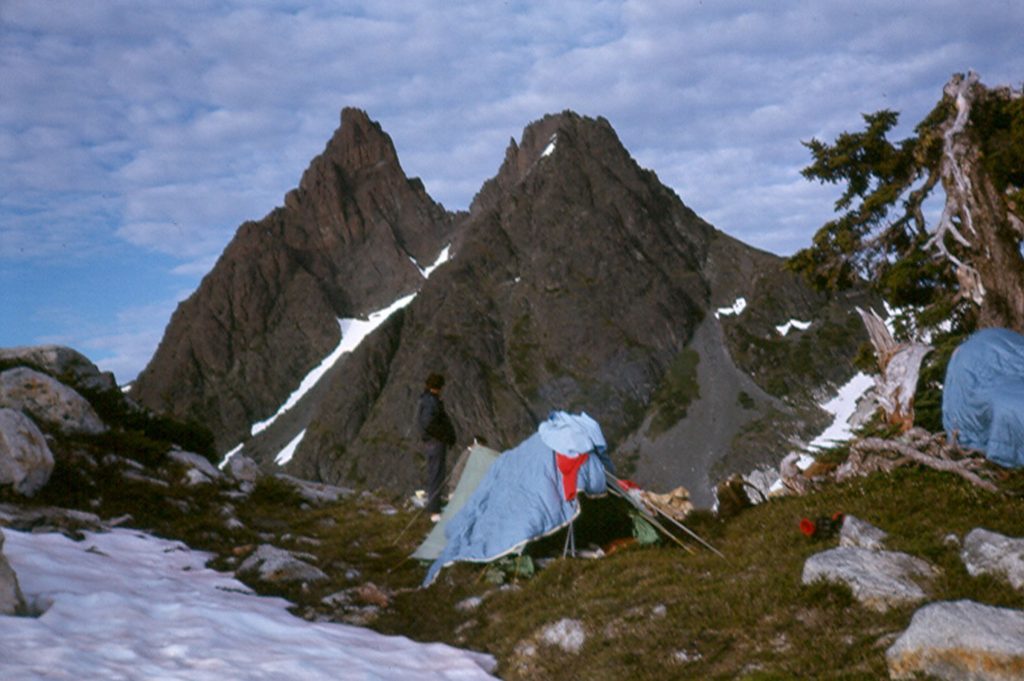
Camp on Elk Pass – Ralph Hutchinson photo.
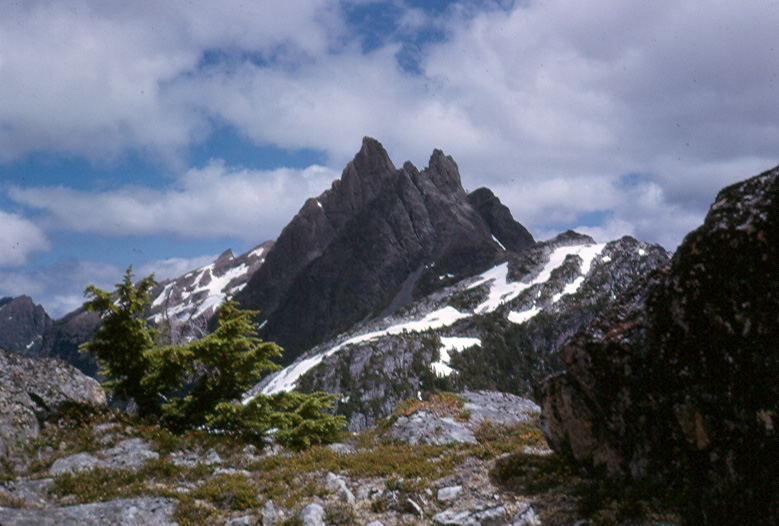
Rambler Peak and Rambler Junior from Elk Pass – Ralph Hutchinson photo.
Strathcona Park – Brief Urges Trail
Reported in The Daily Colonist Friday July 17, 1964. p.16.
By Alec Merriman – Colonist Outdoors Editor
The four outdoor clubs that use Vancouver Island’s Strathcona Park most have called for drastic revamping of the park boundaries to include hundreds of new acres of recreation land. They volunteer to help the provincial parks branch build a 150-mile mountain trail extending from The Forbidden Plateau via Comox Glacier and the high ridge at the south end of Strathcona Park past Flower Ridge, Della Falls Mt. Tom Taylor and north on the west side of Buttle Lake to the Golden Hinde and Elk River. A brief presented to Recreation Minister William Keirnan by the Outdoor Club of Victoria, Island Mountain Ramblers, Comox District Mountaineering Club and Alpine Club have asked that the heartlands of Strathcona Park . . . very finest areas . . . be classified as Class A parklands and preserved as wilderness.
Oppose Mining
They also voice opposition to any mining or logging in the park and ask that “further prospecting in the park be stopped at once.” The brief suggests that to get mining and logging out of parks existing agreements regarding minerals and timber in Class A parks should be exchanged for those of equal value elsewhere.
Reclassification
A re-survey of 825-square mile Strathcona Park, presently classified at a Class B park to fully assess its recreational value is proposed in the brief. The clubs suggest extensive revamping of park boundaries to include recreation-rich Forbidden Plateau and the Strathcona Park game reserve within which it is contained, extending south to Eric Creek and the Carey Lakes, not too far from the Comox Glacier.
Fabulous Lakes
This would bring a score of fabulous summer fishing mountain lakes, skiing areas, and the start of the mountain ridge hiking trail, within the boundaries of Strathcona Park. Other boundary proposals would bring into the park the rest of Buttle Lake on the east, all but the northwest corner of Upper Campbell Lake, and the part of the Elk River Valley at the mouth of the river, which is really the west arm of Upper Campbell Lake.
Class B Areas
The clubs bid for public access to Della Falls and the start of another Strathcona Park mountain ridge trail by suggesting that further logging of the Ash River basin be conditional on the opening first of a public access road to Margaret Lake and Della Falls. They suggest companies logging in the area of the park should build the road. They proposed that the already partly-logged areas of the park in the Salmon River, Ranald Creek watersheds and the portion of Burman, Bedwell and Ash River watersheds lying below 2,000 feet levels be classified as B areas.
New Parks Act
The clubs call for provincial parks act with the firm understanding that park areas could only be abolished by an Act of the provincial legislature. They call for protection against adverse use of the parks including exploitation for commercial and public purposes; inappropriate or harmful recreation use; and problems associated by increased visitation of people.
Alpine Area
The clubs claim Strathcona Park, with the proposed additions, would be one of the finest alpine areas in Canada, lending itself to the very finest high open mountain travel. Club members offer to assist the provincial parks branch in mountain trail building and suggest an order of priority for trail building.
Rambler Peak
Reported in The Daily Colonist Sunday July 19, 1964. p.11.
NANAIMO—The federal government has approved the name of Rambler Peak given by three Nanaimo men to an unclimbed 7,000-foot mountain they scaled last month in Strathcona Park. The three are Ron Facer, Barry McDowell and Steven Todd.
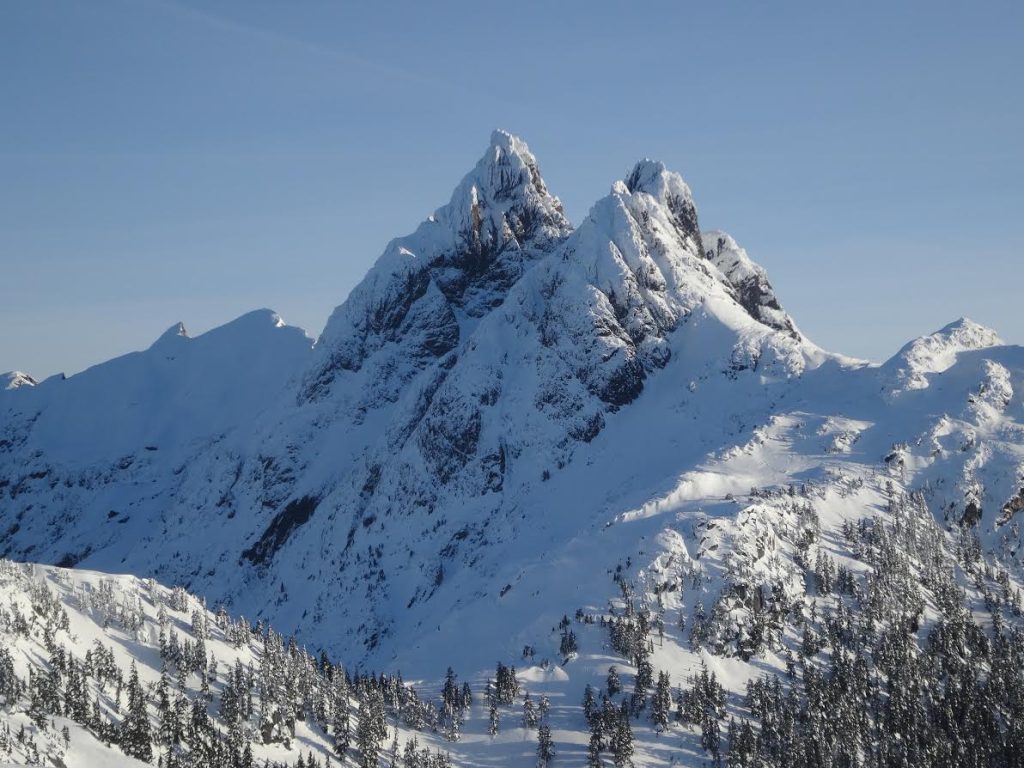
Rambler Peak and Rambler Junior in winter – Ryan Van Horne photo.
Canadian Failure Explained
Reported in The Daily Colonist Tuesday July 28, 1964. p.12.
RAWALPINDI, Pakistan—”There is no reasonable route up to the summit,” of unclimbed 23,000-foot Hachindar Kish in the Himalayas, Powell River school teacher Robert Lyon said Monday. Deputy leader of the first Canadian Himalaya expedition, he was explaining why the mission failed and the Canadians are coming home. The expedition included two Islanders Courtenay engineer Donald Poole and Nanaimo geologist John Ricker.
Outdoors
Reported in The Daily Colonist Friday July 31, 1964. p.13.
By Alec Merriman
John Cowlin, Herb Warren, Doreen Cowlin, and Valerie Lewis of Victoria; Ted Greig and Keith Morton of Royston, and Marc Cusson of Nanaimo, set off this weekend for the mountain ridges of Strathcona Park, where they will join another group of hikers, led by Syd Watts of Duncan, at Tzela Lake in the southern part of the park beyond the Comox Glacier. Some of the group plan to hike 150 miles along the mountain ridges from Forbidden Plateau, around Della Lake and Cream Lake, around the southern end of Buttle Lake, northerly around the ridges, past the Golden Hinde, to come out on the Gold River Road.
Park Mining Must Stop
Reported in The Victoria Daily Times Monday September 21, 1964. p.18.
Commercial exploitation of Strathcona Park should be stopped so that it can remain a wilderness area, Vancouver Island recreation council agreed Saturday. At a meeting in Oak Bay council chambers, the council approved a motion by city parks administrator and Alpine Club member W. Herb Warren that no more expansion be allowed to the mining development permitted in the park by the provincial government. “The character of the park is in danger of being changed unless the commercial aspect is stopped,” he said. Mr. Warren added that the federal government does not permit exploitation of natural resources in national parks and mixing the two is a “completely foreign” idea to persons involved in parks and recreation. The council’s executive will meet in Nanaimo next month to draft a brief to the provincial cabinet regarding Strathcona Park.
Inform Public
Recreation commissions are not receiving their fare share of the taxpayers’ dollars but the fault lies chiefly in the inadequate public information program, the council was told by Duncan Russell, superintendent of Parks and Recreation for Alberni and Port Alberni. “They must have a program worthy of public support and be able to show everyone in the community the value of the program,” he said. Mr. Russell said providing leisure-time pursuits will become increasingly important as automation reduces workloads in the future.
The next five years: 1965 – 1969.
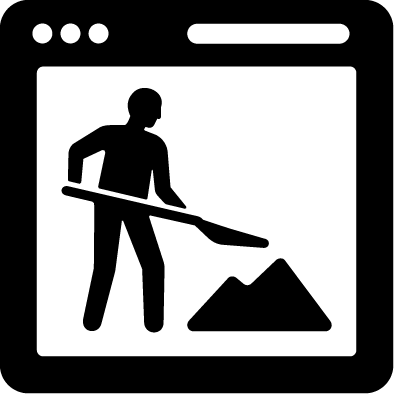
The History of ACCVI is a work in progress.